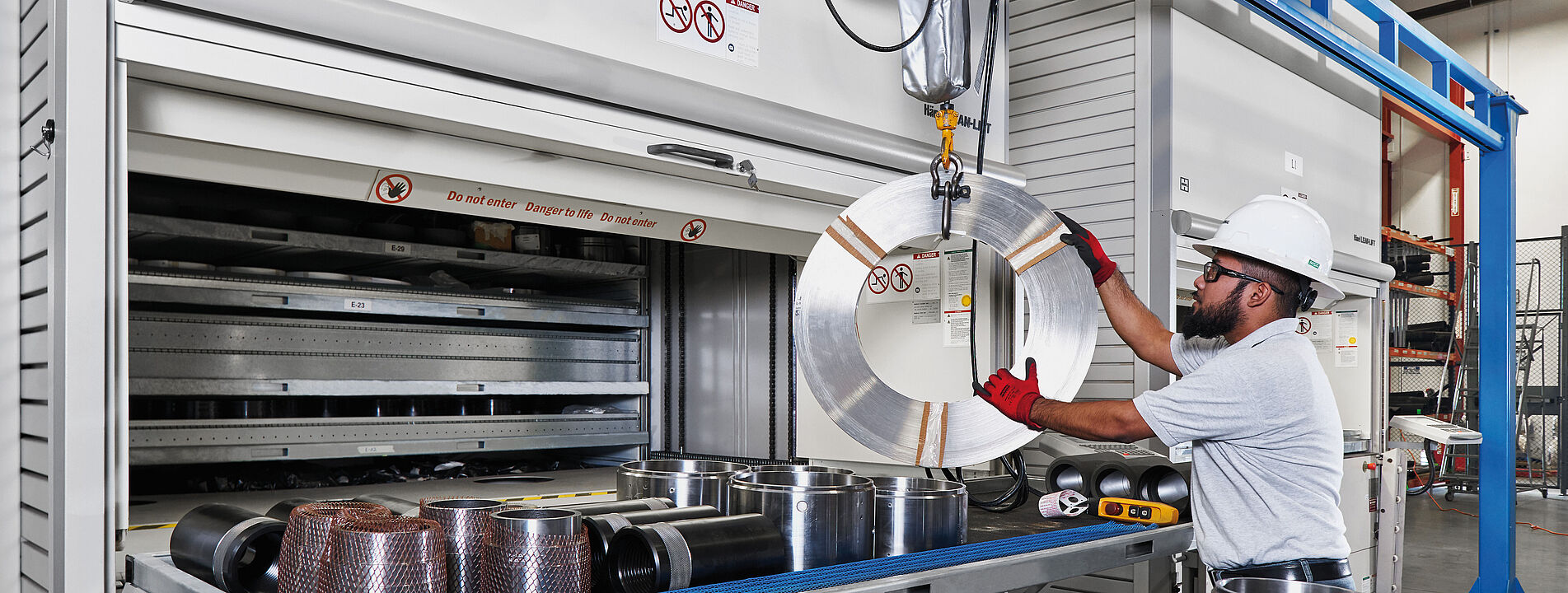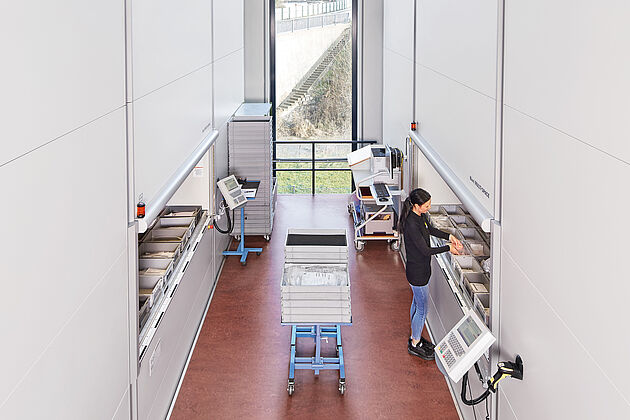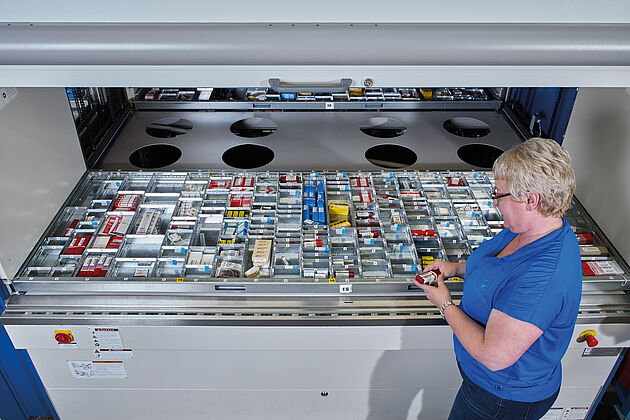Improve Workplace Ergonomics with Automated Vertical Storage
Poor ergonomics in the workplace can cause repetitive strain injuries, musculoskeletal problems, and other health problems for workers. Bending down or crouching, reaching overhead, carrying heavy objects over long distances, and climbing ladders all increase the risk of these injuries, especially when your employees need to perform these movements repeatedly. By bringing items or materials directly to an employee’s waist-high location, automated vertical storage solutions help workers avoid unnecessary high-stress movements and reduce their risk of injury.
Many of these injuries are musculoskeletal disorders (MSDs)(1), which are one of the most common conditions that cause employees to miss work. These disorders involve strain of the muscles, tendons, joints, and ligaments, and they can be caused by either repeated or acute physical exertion. In most cases, they happen gradually over time because an employee needs to remain in an awkward or unnatural position, perform certain movements that strain the body, or lift using less-than-ideal techniques. These injuries come with substantial business costs due to lost productivity, increased employee turnover, and workers’ compensation payments. Redesigning employees’ workstations to create better ergonomic conditions reduces the risk of these injuries, which can lead to happier employees and lower costs. Implementing automated vertical storage fixes the ergonomic problems with many work setups, bringing about these benefits along with others like greater efficiency and better inventory management.
What Is Automated Vertical Storage?
Automated Vertical Storage is a solution that combines tall shelving with a mechanical system that brings the requested shelf or compartment down to the worker, and does so within a condensed storage footprint. This is the ideal ergonomic setup for many workstations. Because the system can bring the item the worker needs directly to waist or chest height, the worker does not need to bend over, reach over their head, or climb ladders to do their job. This reduces the risk of muscle strain and other injuries. Since automated vertical storage also reduces the need to carry heavy items, it further improves the ergonomic conditions and minimizes the risk of workplace injuries.
Benefits of Improving Ergonomics with Automated Vertical Storage
Traditional shelving requires bending and stooping, overhead lifting, and carrying heavy items around the facility. Replacing these shelves with an automated vertical storage solution reduces the risk of workplace injuries, which in turn reduces the direct and indirect costs to your company while improving employee satisfaction and reducing turnover.
1. Minimize Bending, Stooping and Climbing
OSHA identifies work that requires awkward postures, lifting over the head, and carrying bulky loads as risk factors for workplace MSDs(2). To lift and handle heavy objects with the least amount of injury risk, workers should be able to keep these items within eight inches of their bodies and at about waist height(3). The Occupational Safety and Health Administration (OSHA) commonly defines this area as the “Golden Zone,” or the area nearest to the core of the body between shoulders and knees.
If employees need to retrieve items from traditional shelving, keeping to these recommendations can be nearly impossible. Lifting heavier items in this zone reduces stress on the back and lets employees exert less effort. That means their chances of injuries decrease and their energy levels increase, which is good for both morale and productivity.
With automated vertical storage, the storage system brings the item the worker needs to the appropriate height automatically. This minimizes the need for bending, lifting, and climbing ladders, so employees can perform their required tasks with less risk of injury.
2. Reduce Workers’ Compensation Claims
The annual costs directly resulting from workplace overexertion injuries are estimated to be over $13 billion(4). The average workers compensation payment for MSDs and other repetitive strain type injuries averages more than $32,000(5). If many of your workers are performing risky lifting and bending maneuvers frequently, this can quickly become a major business expense. By allowing an automated vertical storage system to do much of the heavy lifting and carrying you need, you reduce the injury risk for your employees, which reduces your workers’ compensation costs.
3. Prevent Employees from Missing Work due to Injury
MSDs caused 30% of missed work days due to injury in the workplace in 2018. This represents a total of 272,780 cases, which caused an average of 12 missed work days per case(6). Missed work days lead to lost productivity, especially because these are unplanned absences. The indirect costs coming from this lost productivity and related factors are estimated to be more than double the $13 billion annual direct costs. This also includes costs like increased insurance premiums and the hiring and training process required to replace the injured employee. The injury itself, along with last minute schedule changes, can be
disruptive. Ergonomic improvements can reduce missed work days by as much as 77%(4). In a warehouse or any other work setting where many different items need to be stored and accessed, automated vertical storage is often the most effective ergonomic intervention.
4. Improve Employee Retention
When well-designed work setups make tasks easier and more comfortable to perform, employees are more satisfied with their jobs. Increased job satisfaction makes it more likely that your employees will stay with your company long term. While an injury might require a worker to leave a job, concern about the risk of injury can also prompt job searching. Improving the ergonomic setup of your workplace can alleviate these concerns. In one example, an Ohio nursing home introduced adjustable-height beds for its residents, which provides a comparable reduction in the need for employees to bend below the level of automated vertical storage in a warehouse or other setting. As a result, injuries declined by 30% and employee turnover dropped 44% within two years(7). Employee turnover can be a substantial expense. Replacing an employee costs about 21% of that employee’s annual salary. Converting your facility from traditional shelving to automated vertical storage makes work more pleasant and less risky for your employees, increasing the chances that they will remain in their positions.
Types of Automated Vertical Storage
Hänel offers a variety of automated vertical storage solution, and we have created lines of solutions that will fit into almost any storage place within any industry.
Rotomat® Vertical Carousel
The Hänel Rotomat® is the ideal solution for smaller spaces, and we offer three standard Rotomat solutions — Industrial Rotomat®, Office Rotomat®, and Lockomat®.
The Rotomat® operates on the Ferris wheel principle, and inventory is delivered to a worker, instead of a worker having to find and retrieve that inventory. Each Rotomat® solution has a microprocessor, allowing integration into existing computer systems for optimized workflows. Hänel Rotomat® carousels are manufactured according to ISO 9001 quality accreditation, attesting to their safety.
The Office Rotomat® allows for rapid delivery of mission-critical files and other office documents in a compact space. The Lockomat® provides the same benefits as the Rotomat® with additional individual security doors to prevent unauthorized inventory access.
Lean-Lift® Vertical Lift Module
Whether you operate in the medical, merchandising, e-commerce, pharmaceutical, aerospace, or even engineering industry, the Hänel Lean-Lift® is the perfect solution for the nightmare of inventory management. This revolutionary system pairs security with speed to deliver products, specimens, and tools rapidly and safely.
The system operates via a computer-controlled positioning lift – the “extractor” – which delivers goods from the storage area to the appropriate retrieval station at the optimal height. The system works by maximizing and optimizing vertical height to store and retrieve products from the safety of trays housed in a secure, shielded storage area. Each Lean-Lift® can hold 132,277 lbs (over 2,200 lbs per tray) but can be custom built to carry a heavier load if necessary.
Both the Rotomat® and the Lean-Lift® are available as refrigerated units for laboratory specimens, ESD versions for surface-mounted devices (SMD), and custom solutions for a variety of industries.
How Hänel can Help
Hänel offers a variety of automated storage solutions that can fit your workplace’s needs and create the ideal ergonomic setup for your employees. The need for bending, extending and climbing is mitigated, and these solutions keep your employees safer while reducing the costs associated with employee turnover and potential workers’ compensation injury claims. Contact Hänel to learn how we can improve your workplace’s ergonomics with automated vertical storage.
Products such as the Rotomat®, the Lean-Lift® and the Multi-Space®
are high-tech products for automated storage solutions
With its numerous inventions, Hänel Storage Systems has made a significant contribution to the success of vertical carousels and vertical lift modules in the field of automated materials handling. This success is yet another incentive for our team to offer future-oriented solutions for intralogistics based on continuous further development.
Hänel storage systems find applications in a wide variety of industries. Operating in sectors such as medical technology, electrical engineering, mechanical engineering, automotive, aviation, pharmaceuticals, healthcare and wholesale – to name but a few areas that demonstrate its versatility – Hänel has the right solution for every application.
Numerous small and medium-size enterprises have also opted for the efficient storage systems from Hänel.
The modern Hänel microprocessor control systems enable continuous inventory updates and accurate inventory control. They can be used as stand-alone storage management systems or in conjunction with customer IT systems.




